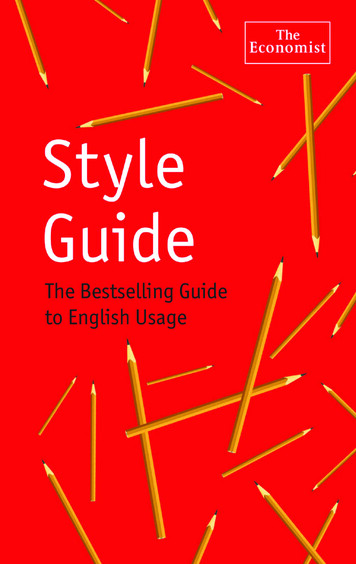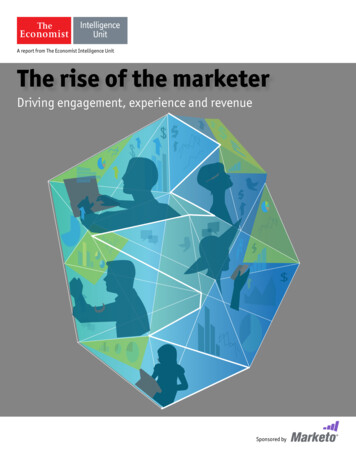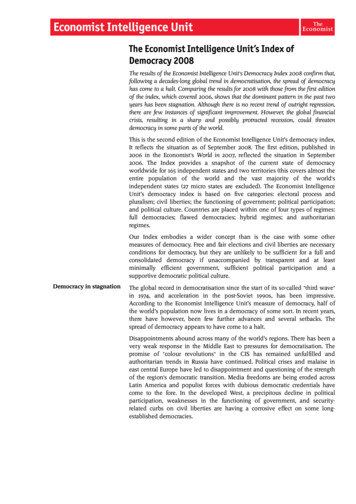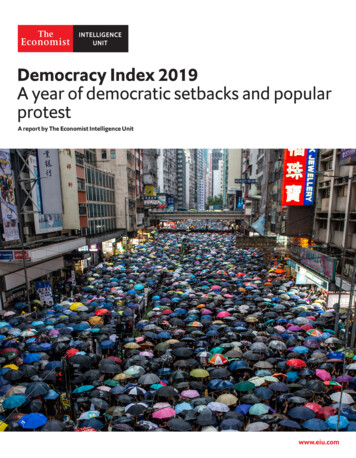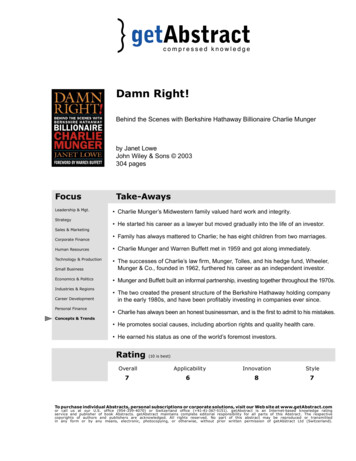
Transcription
Damn Right!Behind the Scenes with Berkshire Hathaway Billionaire Charlie Mungerby Janet LoweJohn Wiley & Sons 2003304 pagesFocusLeadership & Mgt.StrategyTake-Aways Charlie Munger’s Midwestern family valued hard work and integrity. He started his career as a lawyer but moved gradually into the life of an investor.Sales & MarketingCorporate Finance Family has always mattered to Charlie; he has eight children from two marriages.Human Resources Charlie Munger and Warren Buffett met in 1959 and got along immediately.Technology & Production The successes of Charlie’s law firm, Munger, Tolles, and his hedge fund, Wheeler,Munger & Co., founded in 1962, furthered his career as an independent investor.Small BusinessEconomics & PoliticsIndustries & RegionsCareer DevelopmentPersonal Finance Munger and Buffett built an informal partnership, investing together throughout the 1970s. The two created the present structure of the Berkshire Hathaway holding companyin the early 1980s, and have been profitably investing in companies ever since. Charlie has always been an honest businessman, and is the first to admit to his mistakes.Concepts & Trends He promotes social causes, including abortion rights and quality health care. He earned his status as one of the world’s foremost investors.RatingOverall7(10 is best)Applicability6InnovationStyle87To purchase individual Abstracts, personal subscriptions or corporate solutions, visit our Web site at www.getAbstract.comor call us at our U.S. office (954-359-4070) or Switzerland office ( 41-41-367-5151). getAbstract is an Internet-based knowledge ratingservice and publisher of book Abstracts. getAbstract maintains complete editorial responsibility for all parts of this Abstract. The respectivecopyrights of authors and publishers are acknowledged. All rights reserved. No part of this abstract may be reproduced or transmittedin any form or by any means, electronic, photocopying, or otherwise, without prior written permission of getAbstract Ltd (Switzerland).
RelevanceWhat You Will LearnIn this Abstract, you will learn: 1) The life story of Charlie Munger; 2) How he became abillionaire through investments in real estate and corporate acquisitions; and 3) How hehelped Warren Buffett make Berkshire Hathaway successful.RecommendationCharlie Munger’s life story is a version of the classic American Dream: a hard-workingyoung man builds a billion-dollar fortune through hard work and honest business deals,all the while raising eight children with the help of an intelligent, devoted wife. AuthorJanet Lowe brings this story and Munger’s personality to life with well-chosen anecdotesfrom family, friends and business associates. These include, most notably, WarrenBuffett, with whom she already enjoyed a rapport thanks to her work on a previousbestseller, Warren Buffett Speaks. Because Munger’s business history is so complex,the chapters are organized thematically rather than strictly chronologically, whichcan be a bit confusing. Thankfully, Lowe provides a handy timeline in an appendix.getAbstract.com suggests this book to investors, Buffett fans (who may underestimatethe contributions others such as Munger have made to the Berkshire Hathaway empire)and to those dismayed by corporate corruption who could use this tale of honest successto renew their faith in capitalism.AbstractThe Early YearsOn January 1, 1924, Charles Thomas Munger was born in Omaha, Nebraska. His mother,Toody, came from a wealthy family of intellectuals, and gave her son his voracious hungerfor reading and learning. His father, Al, a successful lawyer, was the son of Judge T. C.Munger, a self-educated man who rose from abject poverty to become a federal judge.“If (investing)weren’t a little difficult, everybodywould be rich.” —Charlie Munger“Without numericalfluency, in the partof life most of usinhabit, you arelike a one-leggedman in an asskicking contest.” —Charlie MungerYoung Charlie was steeped in the family values of hard work and self-discipline.Though he worked briefly at Buffett & Son, a grocery store owned by Warren Buffett’sgrandfather, he didn’t cross paths with Warren, who is five years his junior, untilyears later. Charlie left Omaha to attend the University of Michigan in 1941, and leftschool in 1943 to enlist in the Army Air Corps. He was sent to Caltech to train as aweatherman, then to Alaska. Though he never saw combat, his training proved lifechanging in another way: during it, he met and married Nancy Huggins, his sister’sroommate at Scripps College.The young couple moved to Boston so Charlie could attend Harvard Law School, hisfather’s alma mater. Despite having no undergraduate degree, Charlie graduated magnacum laude. In 1949, Charlie, Nancy, and their son and two daughters moved to Californiawhere he joined the law firm Wright & Garrett (later Musick, Peeler & Garrett). In 1953,the Mungers divorced. The children lived with their mother, but remained close to theirfather. Around this time, Charlie invested in a business for the first time, buying part of atroubled transformer company owned by one of his legal clients. The financial pressurecame at a difficult time; Munger’s nine-year-old son, Teddy, died of leukemia in 1955.The Road to RichesIn 1956, Charlie married Nancy Borthwick (friends joke that Charlie wouldn’t be able toremember her name if it wasn’t the same as his first wife’s), and took her two sons from aDamn Right! Copyright 2004 getAbstract2 of 5
previous marriage into his family. They soon had four more children. Charlie spent muchof his children’s early lives at the office, but family has remained very important to him.“Charlie can analyze and evaluateany kind of dealfaster and moreaccurately thanany man alive. Hesees any validweakness in 60seconds. He’s aperfect partner.” —Warren Buffett“There are alwayspeople who will bebetter at something than you are.You have to learnto be a followerbefore you become a leader.” —Charlie Munger“I don’t spendmuch timeregretting the past,once I’ve taken mylesson from it. Idon’t dwell on it.”— Charlie Munger“It is remarkablehow muchlong-term advantage people like[Warren Buffettand myself] havegotten by tryingto be consistentlynot stupid, insteadof trying to bevery intelligent.” —Charlie MungerCharlie’s father passed away in 1959. When he went back to Omaha to help his family,he met Warren Buffett through mutual friends. He and Buffett hit it off instantly. AfterCharlie returned to California, he and Buffett spent hours on the phone, talking overpossible investments. Gradually, Charlie took over the role of business partner andinvestment advisor formerly occupied by Benjamin Graham, Buffett’s mentor and anoriginator of value investing.Charlie entered a real estate partnership with a client in 1961, building the own-your-ownapartments that were coming into vogue in southern California. In 1962, he founded anew law firm, Munger, Tolles, with some of his sharpest colleagues from his old firm.That year, he and client Jack Wheeler started their investment partnership, Wheeler,Munger & Co. Charlie’s first real estate development proved immensely profitable whenhe sold it in 1967, and he continued to invest in similar projects with various partners,including Otis Booth and Al Marshall. Success enabled him to indulge in his passionfor architecture, as well as to hone his business skills by spotting real-estate trends andintroducing new ideas to sell his projects.Many of Munger’s business associates eventually became very successful. Rod Hills, aMunger, Tolles founding partner, later became chairman of the SEC. Hill’s wife, CarlaAnderson Hills, served in the cabinets of both Gerald Ford and George H. W. Bush.Other top lawyers in the firm included Chuck Rickershauser, Ron Olson and RobertDenham. One of the firm’s early clients was Warren Buffett, along with the companiesthat later became Berkshire Hathaway. Though Munger stopped practicing law in 1965,his imprint was deep. The firm’s reputation as an intellectual powerhouse is part ofCharlie’s legacy, as is its democratic compensation structure, under which salaries aredetermined by open ballot.Wheeler, Munger & Co. was a hedge fund in the same vein as the Buffett Partnership,often investing in the same companies and securities. Indeed, Charlie formed it partlyat Buffett’s urging. Rick Guerin started his investment career both imitating Charlieand doing deals with him. Al Marshall joined the firm and later replaced Wheeler. Evencounting the terrible returns of the 1973-1974 stock market downturn, Wheeler, Mungeraveraged an annual return of 24.3% from 1962 to 1975, soundly beating the Dow JonesIndustrial Average annual return of 6.4%.The Genesis of a GiantDuring the late 1960s and early 1970s, Munger, Guerin and Buffett gradually acquireda controlling interest in Blue Chip Stamps. This small company issued tradingstamps, which merchants distributed. Customers collected and redeemed the stamps formerchandise. The investors saw untapped potential in the company’s float account — thedifference between stamps issued and stamps redeemed. Using this pool of capital, BlueChip’s controlling investors acquired several other companies: Wesco Financial — At first, Blue Chip bought part of the company, but it owned80% by 1974. The acquisition led to an SEC lawsuit alleging that Blue Chip manipulated Wesco stock to fight off another merger. The suit was settled, and BerkshireHathaway’s dense tangle of ownership interests was subsequently simplified, withBlue Chip becoming a wholly owned subsidiary. Munger was named Berkshire’svice chairman, his first formal position with the company.Damn Right! Copyright 2004 getAbstract3 of 5
“Playing poker inthe Army and asa young lawyerhoned my business skills Whatyou have to learnis to fold earlywhen the odds areagainst you, or ifyou have a bigedge, back it heavily because youdon’t get a bigedge often.” —Charlie Munger“The investmentgame alwaysinvolves considering both qualityand price, and thetrick is to get morequality than youpay for in price. It’sjust that simple.” —Charlie Munger“A first-rate manshould be willing totake at least somedifficult jobs with ahigh chance of failure.”“Munger takesseriously the obligation of the fortunate to support theneeds of societythat cannot be metby market capitalism.” See’s Candy — Munger and Buffett bought See’s in 1972 for 25 million, a premiumof three times the firm’s book value. At first Buffett was reluctant to pay more thanbook value, because he was schooled in value investing, which teaches investors tofind stocks trading at a discount to book value. But Munger helped him recognizethe soundness of See’s business. The new managers solidified the firm’s competitiveadvantages and savored the pleasure of acquiring a well-run company.The Buffalo Evening News — In 1977, Blue Chip bought this Buffalo newspaper.Charlie called on his legal skill when a competitor brought an antitrust suit againstthe paper. The competitor folded in 1982, but even without competition, the paperstruggled during a recession. Charlie’s personal fondness for newspapers led him tostick with it, and now it is among the most profitable newspapers in the U.S.Charlie experienced some difficult personal problems in 1977. His mother passed away,and a bungled cataract operation left him blind in one eye. He did not let itstop him. Berkshire Hathaway acquired companies rapidly in the late 1970s andthroughout the 1980s. Having learned from See’s that some companies were worth apremium price, Munger and Buffett expanded their horizons. Their investments includeGEICO, Nebraska Furniture Mart, Boersheim’s (an Omaha jeweler), ABC, Gillette,USAir, SAFECO Corporation, Champion International and Coca-Cola. In the 1990s,Berkshire’s growing reputation allowed it to make more deals on preferred terms,concentrating on the insurance industry. The 22 billion buyout of General Reinsurancegave Berkshire Hathaway the highest net worth of any U.S. company, and solidified itsposition as an insurance giant.Berkshire pays officers and directors relatively low salaries and keeps its overhead to abare minimum. Buffett’s private jet is named “the Indefensible” in response to Munger’sjabs. The management philosophy relies on a few simple ideas — recognize value,closely scrutinize deals, face trouble head-on — rather than complicated, mysteriousgrowth formulas. Over time, the firm and its management have developed what can onlybe called a cult following.Doing Honest BusinessCharlie’s business integrity stands out in two examples: his battle with the savings andloan industry in the 1980s and his role in the turnaround of Salomon Brothers in 1991.As Wesco Financial’s chairman, Charlie predicted the S&L crisis of the late 1980s. Asearly as 1983, he warned that government deregulation of S&L lending powers couldlead to increasingly unsustainable loan practices. Wesco gradually moved out of the S&Lbusiness and recreated itself as a holding company. Munger invested in Salomon Brothersand the Federal Home Loan Mortgage Corporation (Freddie Mac). Hence, Wesco was nothit very hard when S&Ls began to fail, prompting a massive government bailout. Charliewas outraged by the lobbying practices of the U.S. League of Savings Institutions, theS&L trade group. The lobbyists, he charged, wanted to preserve unsound regulations andresist accountability for the industry’s problems, at a huge cost to taxpayers, investors andpublic faith in savings institutions. He took Wesco out of the League in 1989, and gave upits S&L charter in 1992, all while calling publicly for strong governmental reforms. TheLeague ultimately collapsed, confirming Charlie’s predictions.In August 1991, Munger and Buffett, both members of Salomon Brothers’ board ofdirectors, discovered that a trader at that firm made illegal bids for U.S. Treasurysecurities. To make matters worse, the company’s top executives, John MeriwetherDamn Right! Copyright 2004 getAbstract4 of 5
“Charlie recognized Warren’sgenius before anybody. If I had listened to Charlieabout Warren I’dbe a lot richernow.” — Al Marshall, Munger’sinvestment partner“Though Mungercan be self-willed,preoccupied andabrupt, says Buffett, ‘He’s just thebest pal a guycould have.’”and John Gutfreund, had known of the violation for four months but had withheldinformation from the board. Munger pressed for full disclosure and the resignations ofthe officials who had known of the illegal trades. Grasping the legal implications, hebrought in top lawyers, such as his old partners Denham and Olson. Due in part toMunger’s tireless work, the case damaged Salomon but did not break it. The firm wasfined 290 million but no criminal charges were filed. Denham eventually became CEO,turned the firm around and sold it to Travelers Group Inc. for 9 billion in 1997.A fascinating postscript: A group of unhappy Salomon employees left to form ahedge fund called Long-Term Capital Management (LCTM). Due to flawed real estateinvestments and an unsound leverage, the fund came perilously close to collapsing andcausing serious damage to the U.S. economy. Although Buffett offered to bail out thefund, LTCM rejected the deal and was afterward rescued — under government pressure— by a bank consortium.Charlie Puts His Money Where His Mouth IsMunger believes in financially supporting social causes. Though he is a Republicanand tends to social conservatism, he has staunchly supported abortion rights, with farreaching consequences. He first became involved in 1969, when he convinced Munger,Tolles to defend Dr. Leon Belous, who was convicted of referring a woman to anabortionist. He persuaded many top lawyers to sign a friend-of-the-court brief, and thedoctor was acquitted in a reversal of California’s anti-abortion law. This case was oneof the building blocks for the Roe v. Wade case three years later. Charlie later became atrustee and chief financial officer of the Los Angeles chapter of Planned Parenthood, andhis views have stayed the same.Charlie also directly champions the cause of health care. A friend asked him to join theboard of the not-for-profit Good Samaritan Hospital, and he soon became chairman. Hetreated its short-sightedness and mismanagement just as he would have treated corporatecorruption: he fought it. Though some doctors left, Munger recruited many more. GoodSam, as it is fondly known, has grown into a well-respected hospital that ranked amongthe best in the country in a 1998 U.S. News & World Report study. The transition waslong and difficult, but Munger believes it was worth it.Charlie was a millionaire by 1970, but he continued to reinvest his money as each dealpaid off. When Berkshire Hathaway reorganized in the early 1980s, Munger owned 2%of its stock, for which he had paid approximately 40 per share. Today each share isworth more than 60,000. Although he owns several homes across the U.S., he likes tokeep his expenses minimal and refuses to conform to standard business practices, likeaccepting exorbitant director fees that cost shareholders money. It is fair to say that hegot his wealth the old fashioned way — he earned it.About The AuthorJanet Lowe, an investment writer and author, wrote Warren Buffett Speaks, as well asWelch: An American Icon and The Man Who Beats the S&P: Investing with Bill Miller.She has served as editor of the San Diego Daily Transcript and financial editor of the SanDiego Tribune. In addition, she has published more than 200 business articles.Damn Right! Copyright 2004 getAbstract5 of 5
The successes of Charlie's law fi rm, Munger, Tolles, and his hedge fund, Wheeler, Munger & Co., founded in 1962, furthered his career as an independent investor.





